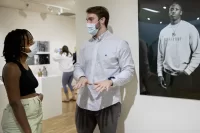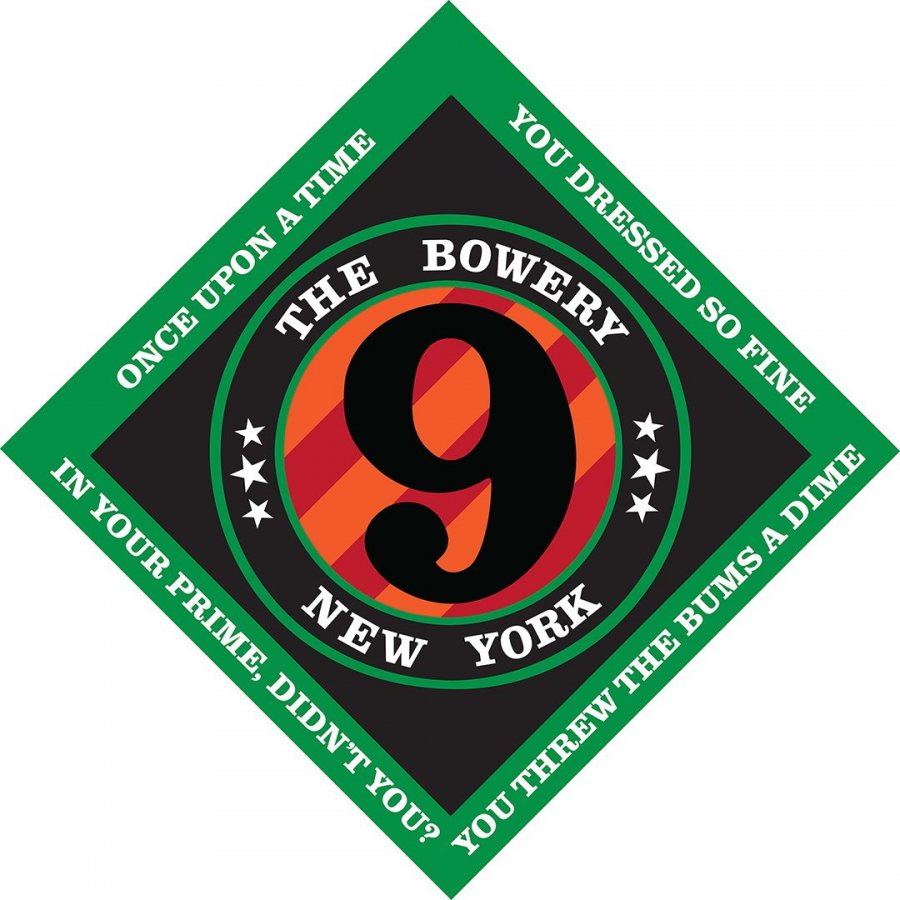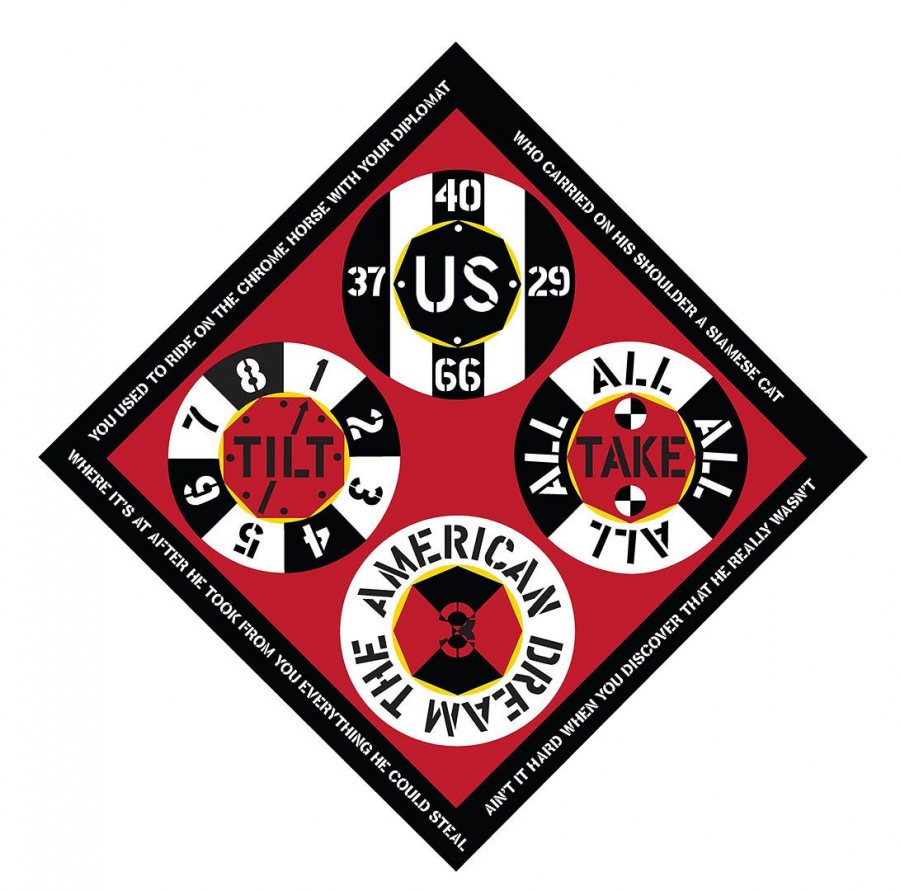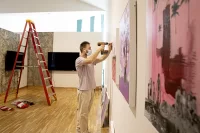
Bates to debut Robert Indiana prints based on Dylan’s ‘Rolling Stone’

“Once Upon a Time” (2016), silkscreen in colors on triple-primed canvas from the “Like a Rolling Stone” series by Robert Indiana.
Dan Mills, director of the Bates College Museum of Art, was amazed by his first encounter with a new series of silkscreen prints by famed Maine artist Robert Indiana.
“These are so powerful,” he thought. And, after all, how could Indiana’s interpretations of lyrics by Bob Dylan be anything but powerful?
Opening June 10, an exhibition at the Bates museum will feature the premiere of Indiana’s Like a Rolling Stone — a series merging the sensibilities of two of the 1960s’ definitive pop-culture figures, Dylan and Indiana.
Rendering lyrics from Dylan’s groundbreaking hit in Indiana’s unmistakable style, the 12 prints form the centerpiece of the exhibition Robert Indiana: Now and Then. (Dylan performs in Portland, Maine, on July 14.)
Now and Then spans the career of a seminal Pop artist whose image “LOVE,” with its signature tilted “O,” is one of the most recognizable works in American art. Including the Rolling Stone images, the show comprises more than 70 works representing such Indiana icons as “EAT,” “HOPE,” and “THE ALPHABET.”
“Much of Indiana’s work is about the continued exploration of variations on themes,” says Mills, and Now and Then will reflect that side of the artist.
But in the Dylan works, says Mills, “each is very distinct from the next. It’s an incredibly dynamic group as a result, and I’m really excited that we will be the institution that introduces these to the world.”
One of America’s foremost living Pop artists, Indiana is a longtime resident of Vinalhaven, an island off midcoast Maine. In addition to debuting the Dylan adaptions, the Bates exhibition showcases his versatility in rendering a given image on paper and canvas, in prints, and in three dimensions.
Indiana draws his subject matter from the visual vernacular such as commercial logos, road signs, and factory die-cut stencils, while incorporating the heritage of Modernists such as Charles Demuth and Marsden Hartley. The well-known “LOVE,” conceived originally as a post card for New York’s Museum of Modern Art, has appeared as sculptures, paintings, drawings, prints, and as a U.S. postage stamp.
Indiana began the series about two and a half years ago, says Michael McKenzie, a longtime colleague of Indiana’s who curated the Bates exhibition and published the catalog for an earlier version of the show, The Hope of Art.

“Tilt,” silkscreen on triple-primed canvas from the “Like a Rolling Stone” series by Robert Indiana.
In the past, Indiana had based artworks on writings by Walt Whitman and others. McKenzie, thinking of a 2010 artist book that photographer Ed Ruscha had made from Jack Kerouac’s novel On the Road, suggested that Indiana return to literature for inspiration.
Dylan emerged as the natural choice of author. For decades, McKenzie says, Indiana routinely listened to Dylan in his studio. “I’d have to say that no musical artist has influenced me as much as Dylan, and probably no poet has influenced me as much as Dylan,” Indiana told McKenzie.
And just as Dylan was the natural choice for Indiana to adapt for his work, the most potent choice for a Dylan song was “Like a Rolling Stone,” an excoriating indictment of a precarious debutante that galvanized pop radio in 1965. (The song is said to be about Edie Sedgwick, one of the most prominent and tragic members of the circle around Andy Warhol in the 1960s.)
“The way Indiana has integrated Dylan’s lyrics — the few people who have seen the work, it has blown their minds,” McKenzie says. “We’re starting to realize this is a very important project.
“The significance is that you have the greatest shape poet of all time” — that is, someone whose poems take the physical shape of their subjects — “collaborating with the greatest rock poet of all time,” McKenzie says. “To see Robert Indiana figure out Bob Dylan was pretty intense.”
Born Robert Clark in 1928 in Newcastle, Ind., Indiana graduated from the Art Institute of Chicago, where his fellow students included Pop artists Claes Oldenberg and Red Grooms, and the Photorealist painter Richard Estes.
In 1956, he moved to New York City and became one of the founding fathers of Pop Art. He moved to Vinalhaven in 1970.
Indiana’s work is represented in more than 1,000 collections in 100 countries including the Bates museum, Museum of Modern Art, Metropolitan Museum of Art, Whitney Museum of American Art, Los Angeles County Museum of Art, Stedelijk Museum Amsterdam, and The Louvre.
Now and Then is based on an exhibition organized by Landau Traveling Exhibitions of Los Angeles, in association with American Image of Katonah, N.Y., and Rosenbaum Fine Arts of Boca Raton, Fla.
The exhibition is funded in part by generous gifts from Ingrid and John Amols ’72, in memory of Philip M. Isaacson ‘47, and from Jane Costello Wellehan ‘60.

![Man Ray (American 1890-1976)[Marsden Hartley], 1925Gelatin silver printGift of Norma Berger1955.1.118](https://www.bates.edu/news/files/2019/09/Hartley_Ray_HZ-200x133.jpg)


